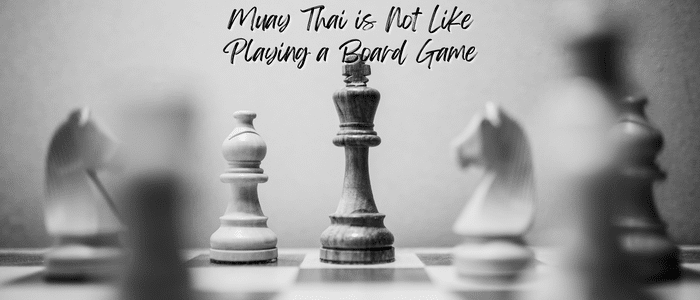Training and fighting in Muay Thai is not like playing a board game. You can’t just roll the dice, hit a 5, advance 5 spaces, roll again, hit a 6, move that many spaces forward and just like that you are only a few steps away from the end of the board game. Learning doesn’t work that way.
Instead, it’s more like chess: slow, calculated, methodical. It takes time to learn and build a strategy. It takes time to play the game. You have to watch your opponent and think several steps in advance, while they are doing the same.
Maybe you need to lose a few times to get better, not willingly, but lose to someone that is better than you. I think that we sometimes forget this analogy or have simply never adopted it.
I want to address the “I want it now attitude.” Training in Muay Thai, or anything for that matter, takes time, energy, effort, and sacrifice. Real sacrifice, like the kind of sacrifice that on the days that you want to go home and quit, but you don’t. You can quit, you can go home and never train again. Your friends or family that don’t train will love and support you either way. They don’t care. But in doing so, will you have truly learned anything?
I was talking to a friend the other day about the level of amateur fighters in America compared to Europe and elsewhere in the world.
In Europe they have what’s called C class, B class, and A class levels. You are required to keep track of each fight in a small book called a fight book, much similar to the way USA boxing does. Along with that they also have a rule where you are not allowed to move up a class until you have completed 25 fights in each class. In America, this is not the case. Amateur fighters here are not really developing a good strong foundation in the basics of training and winning a fight.
In Europe C class means you’ve participated in 25 amateur fights. If you were to fight an average of once a month that would be 12/year and 24/2 years. Let’s say at some point you fight in a tournament, so maybe you rack up a few fights more than average. One year you do a tournament and win, so possibly you had 3, 4 or even 5 fights in one weekend so you built your fight record a little faster. You are still at 1 ½ years as a C class fighter at minimum while consistently training and fighting.
An average American amateur fighter has 8-10 fights a year; pro even less.
This does not account for any injuries you sustain during your fights, time off from over-training, or life outside the gym. So, let’s say we are now pushed back to the 2 year mark as a C class fighter. You’ve reached your 25 fights and are ready to move up to B class. B class, for those of you that don’t know, is semi-pro. You fight with no shin pads, no headgear and use elbow pads. However, you still don’t get paid and are considered an amateur.
Again, you start over and need to accumulate 25 B class fights, and the process is the same. Let’s say that you cannot fight as much now because injuries are a little more severe and the recovery takes a little longer. Let’s say now it takes you 3 years to get all 25 B class fights.
In this scenario you have been training and fighting for 5 years total, with a total amateur fight experience of 50 fights before going into A class; you’re now a pro!
I know this is a long-winded explanation, but my point is this: if fighting is something that you want to do, or even just learning Muay Thai, you can’t roll the dice, jump 5 spaces, and win the board game. You have to take it one day at a time. You have to put in the sacrifice, you have to go through the hard days and the great days.
The only way that the level of Muay Thai in America and in yourself will rise up to the rest of the world is for more people to understand this. Really, I guess you could apply this thought to anything in life that you are trying to achieve.
Final thoughts… Amateur fighters need more time in the gym and need to fight more if they are going to take fighting seriously as a profession. Also, if you have never lost in a fight or been down in the scorecards, fighting your way back for a win, then you never have been pushed to your limits. You don’t know what you are truly made of. In that moment, in the small window of time, you get to make a decision: do I quit, or persevere?
Only you can answer that question. Even more so, you can only answer that question when you are in that moment. Something to think about.
As always, train hard, be a beast!

